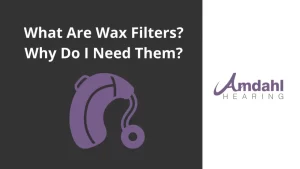Those of you who have hearing aids are very likely familiar with wax filters or wax guards. For those of you who don’t know, a wax filter is a very small piece of plastic that’s inserted into the speaker of a hearing aid. The goal of the wax filter is to keep wax from reaching the speaker and creating mischief.
One of the questions I often get is “why do we need wax filters when they are constantly making my hearing aid stop working?” Good question. To give you the answer, I need to go back in time a little bit, way back to when I first started in the industry in the early 90s.
Hearing Aids of the Past
Back in the 90s, we had two options to deal with wax inside hearing aids. First, and the most common, was no protection whatsoever. Patients would have to manage wax with a long wire loop. The loop was used to scoop excess wax out of the hearing aid. Not only was this more than a little gross, but it also wasn’t very effective. Ultimately patients would end up with wax completely plugging their speaker and would have to send their hearing aid in for repair. The other option was something called a spring wax filter. Spring wax filters were a little bit of improvement, however, patients still needed to use the long loop to clean excessive wax out of the speaker. The benefit of the spring wax filter was that it could be removed and the hearing aid would work just fine. The downside of this is that the wax filter needed to be removed by a professional. So if your hearing aid were to stop working on a Friday evening, patients would have to do without their hearing for the entire weekend.
Modern Advancements in Hearing Aid Care
Fast forward to a few years ago, and the modern wax filter was introduced. The upside of this wax filter is that it can be changed as often as possible by the patient by simply using a removal tool to take out the plugged wax filter. Once the soiled filter is removed, the patient can use the same tool to insert a new filter. Filters come in packs of around eight, are inexpensive, and are simply disposed of when they are soiled. The downside is that the hearing aid tends to plug up a little bit more often. The significant improvement is that patients can take care of the problem on their own, even if they don’t have extra wax filters. Running the hearing aid with no filter is not a problem for a short period of time.
In my opinion, modern wax filters have saved more evening or weekend plans than just about any technology in the history of hearing aids. If you don’t use them, I strongly suggest looking into them!
If you have any other questions regarding wax filters or anything having to do with hearing loss or hearing aids, please give us a call at 320.252.0094, look up online at amdahlhearing.com or email me directly at info@amdahlhearing.com
